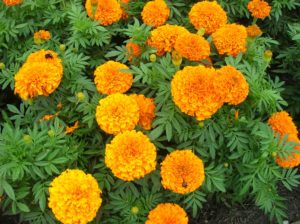Hello readers! Ticking down the time till Friday, Are you ready to learn about the Marigold? Whither you are, or you just wanna press that snooze button again, Here we Gooooooooooo!
The earliest mention of Marigolds I’ve found is from mentions by the ancient Aztec civilization who used the plant for magical, religious, and medicinal properties, with the fist officially recorded use being in the De La Crus-Badiano Aztec Herbal of 1552 which cures hiccups, being struck by lightning, and “for one who wishes to cross a river or water safely,” confirming that the Aztecs believes in the Marigold’s ‘magical properties’. The Aztecs also selectively bred the marigolds to have increasingly larger blooms, before the Aztecs carefully cultivated seeds were taken by early Spanish explorers to Spain and cultivated in monastery gardens.

From Spain they were transported to France and Northern Africa, growing taller before coming to Mexico and Latin America, decorating household altars in celebration of All Saints Days and All Souls Day. Flower heads were scattered on relatives’ graves, causing a small outbreak of Marigolds in the cemeteries there. It is observed by people back then how the Corn and Pepper decorations match the Marigold in the exact same shade of orange-yellow. It’s almost as though the corn and peppers were selected or bred to match the Marigold flower color.
Several hundred years from their initial journey from the Aztec’s to Europe and Africa, Marigolds were introduced to American gardens shortly after the Revolutionary War. Around the turn of the century sweet peas and asters were the popular flowers in the gardens of USA, but were being beleaguered by disease and declining overall performance. Then, in 1915 David Burpee took over the national seed company and decided that Marigolds held promise and put them in the catalog and funded research for it.
Now, thanks to David, beginning in the 1920’s Marigold breeding has developed hundreds of new varieties. It seems fitting that Marigolds would make a circle around the world before gaining breeding emphasis and popularity in the land of America, where it originated. I, for one, would plant it for its ability to repel bugs. This has been a brief history of the Marigold, see you in 2 weeks’ folks!

